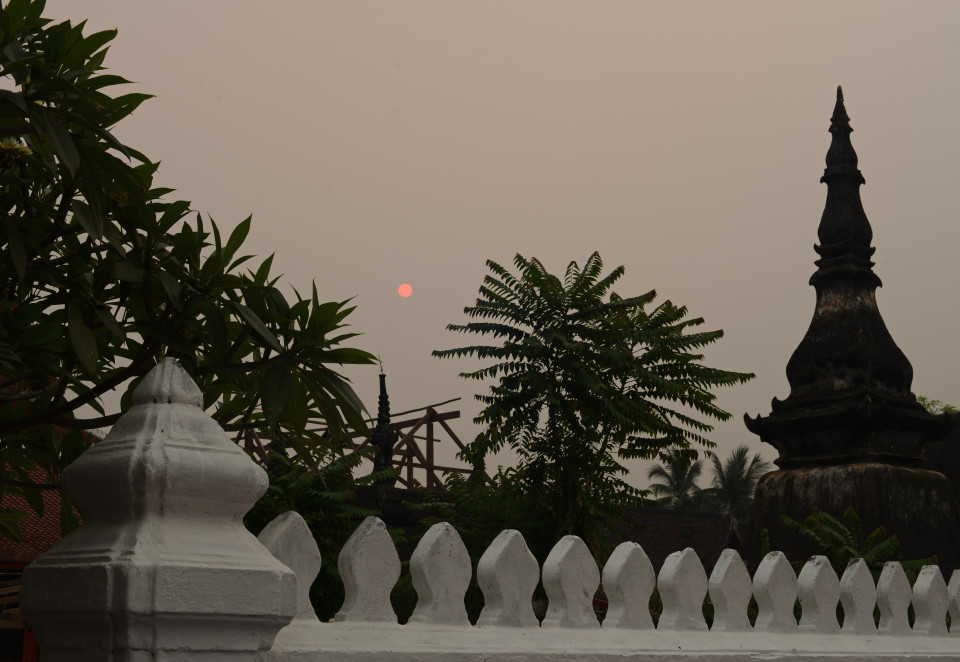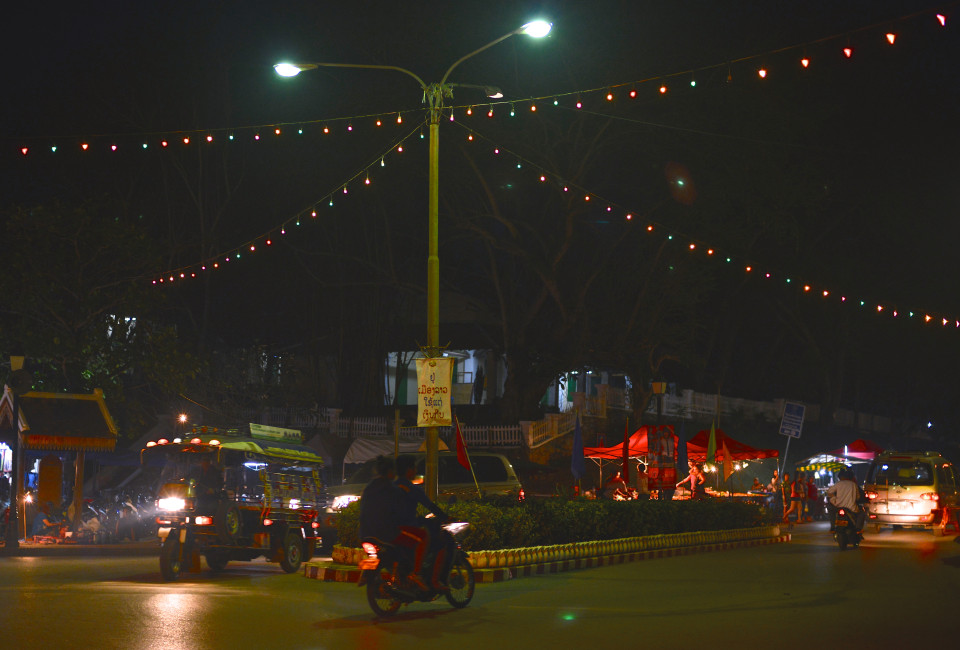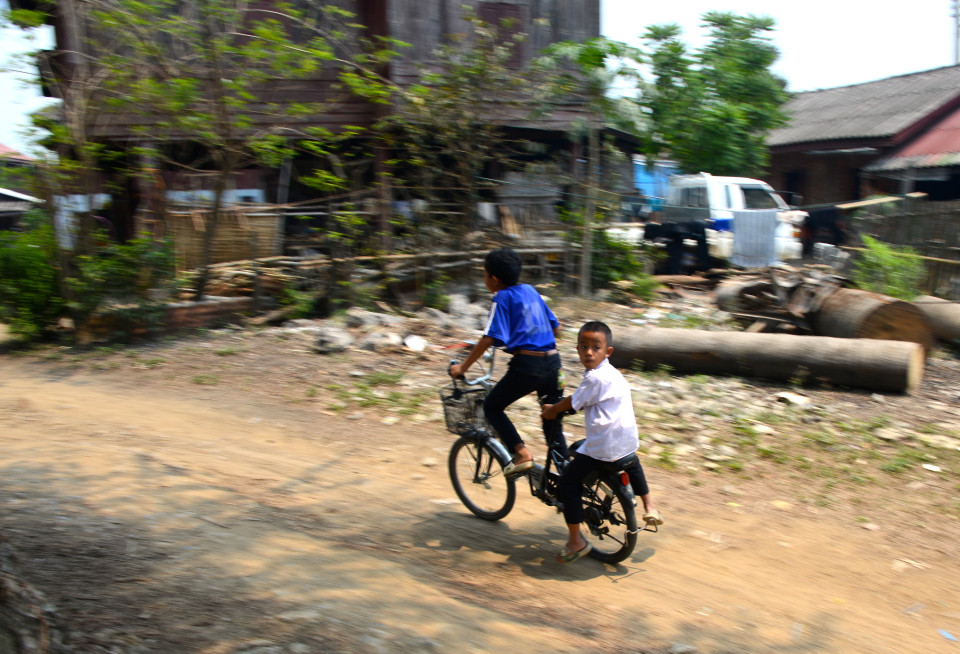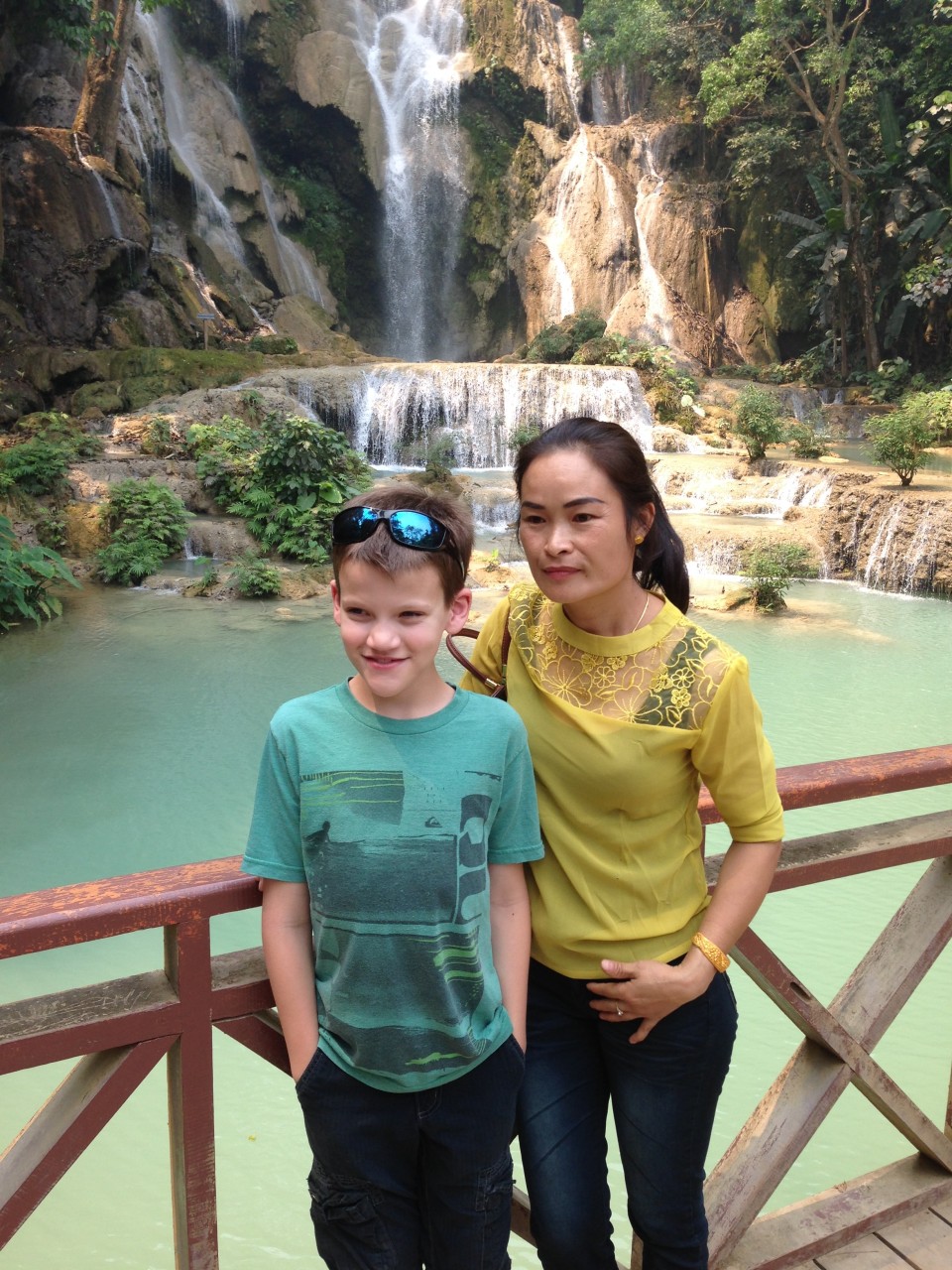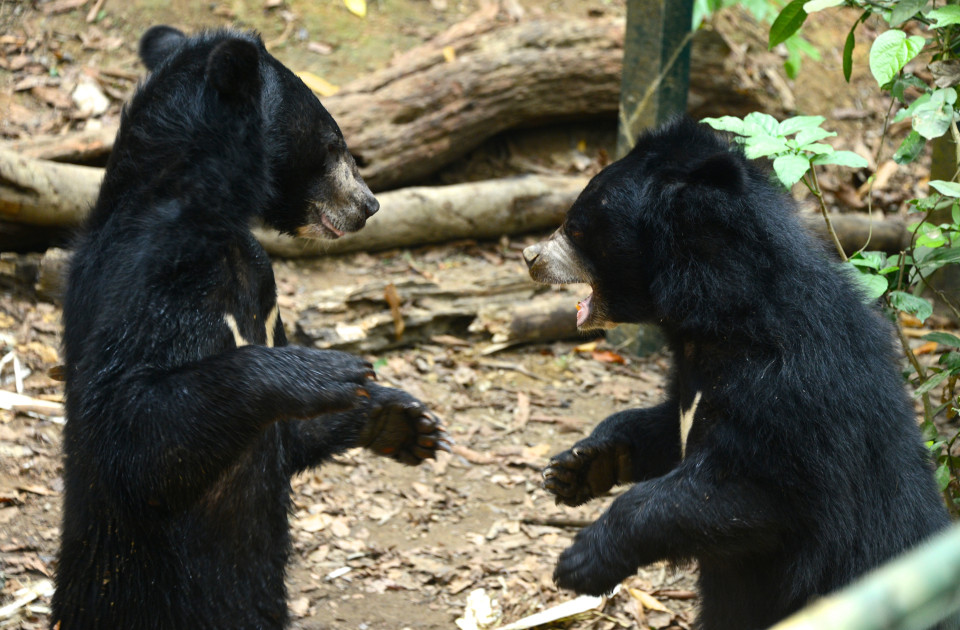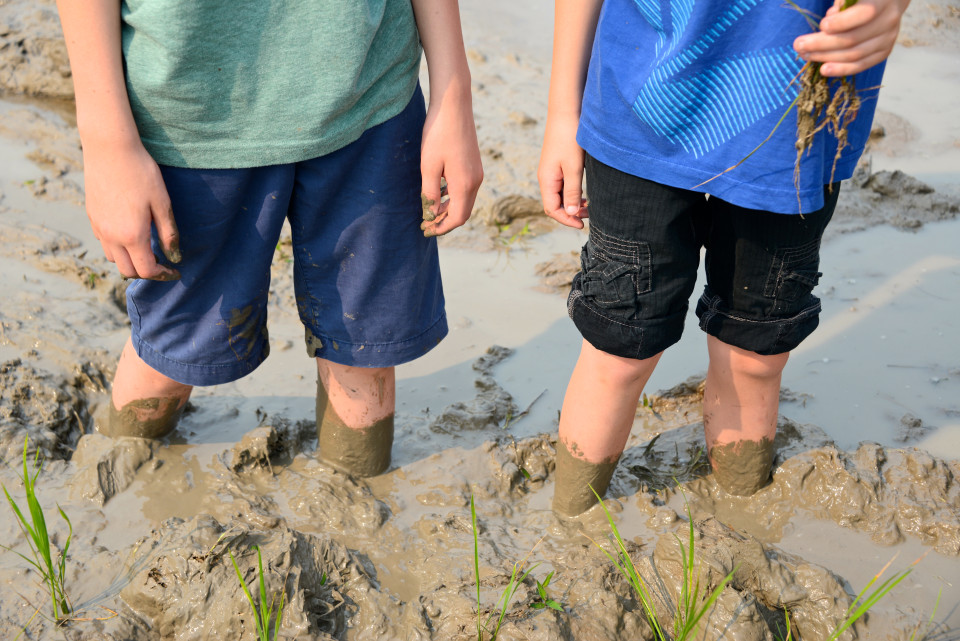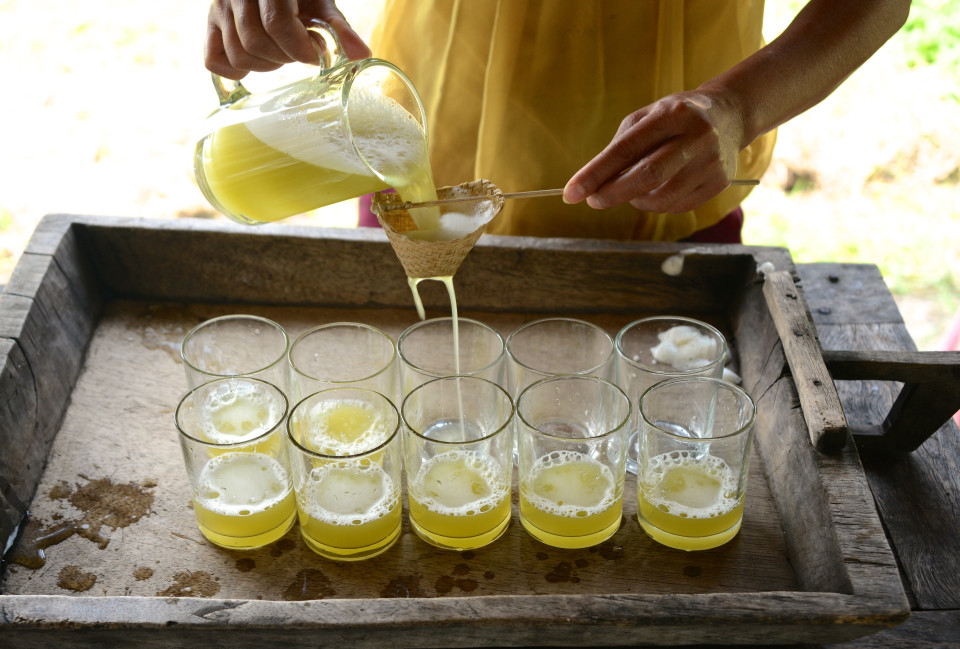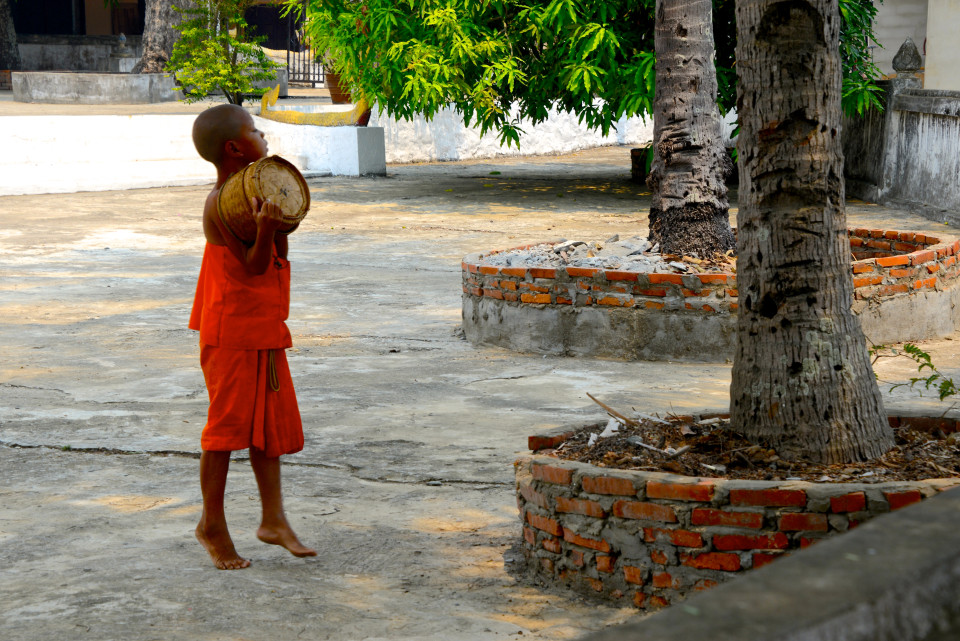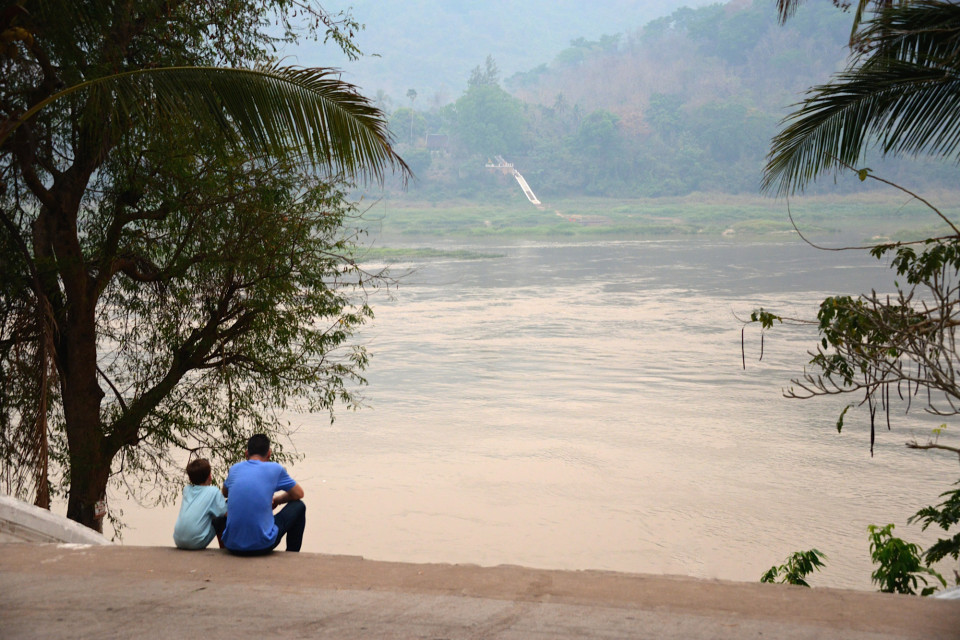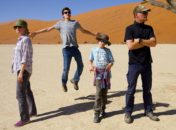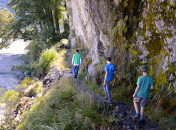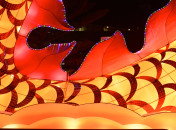It was night when we landed; as we walked a quarter mile across the tarmac to the terminal, flakes of black ash gently spun around us like maple seeds in dry August.
Luang Prabang International Airport is one of three airports in Laos that accepts foreign travelers. It is also considered a relatively dangerous place to fly into, set as it is among the mountains. Our arrival coincided with the front-end of the rice season, so the air was filled with thick smoke and ash from farmers burning their fields in preparation for irrigation and planting.
After going through queues for our visa, border control and customs, we were greeted by Mr. Ting and Mr. Ae, our guide and driver respectively, for the next three days. Despite being a relatively small town of around 50,000 full-time residents, Luang Prabang is the major Laotian tourist destination and the village swells with visitors from China, Japan, Korea and Australia. Even the short six kilometer drive was challenging, as hundreds of motorbikes loaded with engorged burlap bags of rice or stacks of decorative tiles and lumber swirled through the smoke around us. On the way to the hotel, Mr. Ting loaded us up with lots of facts about the town and our itinerary for the next couple of days, and he made several recommendations about where to eat, drink and shop. But we were tired from the long day and mostly just nodded our heads.
First impressions being what they are, Luang Prabang strikes one immediately with its crumbling architecture and languid flow. Laos is not so much a coherent whole, but a jumble of cultures merged into one ad hoc accretion. The Mekong River here courses through the mountains, split into various channels of brown or black water.
THE SKY IS FALLING
Our first full day in Luang Prabang was spent lounging around in the cool air-conditioned comfort of the hotel, a small and nice resort-like place away from the city center. After hiking through the Den Thang mountains of Sa Pa, we were all exhausted and sore, so a ‘down day’ of reading, writing and schoolwork was a treat. Asher and I swam for hours as blackened chunks of ash fell from the sky into the pool. The sun burned red through the haze every day we were there.
Mr. Ting picked us up at 9:00a the following morning for a day of visiting the regions’ most popular and cultural destinations. We traveled about 30km south of the city along difficult, teeth-shattering roads. They were similar to many we saw in the remote areas of southeast Asia – roughly composed of gravel and rock, muddy in the rainy season and dangerously elevated several meters above the surrounding farmland. No guard rails to prevent catastrophe. No clear rules governing right of way. No places to pull out for bigger vehicles. So we white-knuckled the door handles at each close call with a tuk-tuk or passing truck.
The horn is used more in SE Asia than anywhere we’ve ever been, and it’s not regarded as an aggressive move. Unlike in the U.S., where honking to alert the car in front of you that the light has changed while they were texting or checking Facebook means you’ll get a glare or flipped off, the horn in Laos just means ‘watch out,’ ‘I’m here,’ or ‘I see you.’ Flashing one’s lights means ‘I’m coming through.’ And no matter how close vehicles come to knocking a motorbike carrying a mother and baby into the rice fields, no one loses their temper. They just flow.
We drove through dusty villages with kids running around without pants, similar to what we saw in Sa Pa. Houses are concrete pads with stilts up to a single bamboo-sided room and thatched roof. Hammocks are hung in the relative cool underbelly – one for each member of the family. In the middle of the floors, open pit fires smoked and kids covered in dirt played as their moms cooked or washed laundry.
PHOTOS WITH STRANGERS
There is a convoluted wooden gate and guardhouse at the base of the trail leading to the Kuang Si waterfalls. It is surrounded by a patchwork of lean-tos and shacks where villagers sell all sorts of items – postcards, waters, coconut water, dragon fruit, various meats on sticks, sodas, Beerlao t-shirts, handbags, khao tom mad and Mentos.
The falls are a series of naturally created sandstone pools where visitors swim in the cool pristine waters with schools of tiny fish that cluster along the muddy banks. Along the path there are many signs prohibiting anything but modest attire in the water – no bikinis, no thongs. Two older women approached Asher and began taking pictures with him – something that has become common during our travels. He was, as always, a patient and accommodating model – who above all else relished the attention.
BEAR SANTUARY
The Free the Bears Fund is a non-profit sanctuary for Asiatic Black bears that have been farmed for their bile, which is used centuries-old traditional medicine. We were lucky enough to catch the bears at their first feeding, in which keepers hide food and honey in bamboo or banana leaves. An elevated wooden walkway skirted the enclosures, putting us very close and above the bears. We watched groups of bears wrestle with each other over who got the biggest bamboo canes and then try to figure out where the honey was. They gnawed at the poles and peeled the banana leaves away from the food bundles one leaf at a time like they were counting out money. After eating, the bears splashed around in the ponds and thrashed about in the tropical brush. This was one of the happiest and healthiest appearing mammal sanctuaries we’ve ever seen.
While the rest of the family was listening intently to Mr. Ting and enjoying the scenery, I was losing a fight. I had a fever that I was trying like hell to ignore. The previous day, I’d eaten something that I knew didn’t taste right, and now I had a full-on stomach bug. While not uncommon in Southeast Asia, it was not something I wanted to manage in a country that has only 57 Western-trained physicians inside its borders. As the day progressed, so too did my fever.
CULTURAL TAPESTRY
It’s not much to look at, wedged as it is in a potholed alley next to a doughnut bakery, but the Traditional Arts & Ethnology Centre (TEAC) is an excellent museum for learning about the tribes of Laos. Like Vietnam, the mountainous regions of the country are filled with indigenous peoples. The government has recognized more than 150 ethnic groups that speak a total of 82 unique living languages. According to the museum’s curator, a national classification was made in 1975 based on geographical distribution. There are three categories: Lao Lourn (inhabitants of lowlands, valleys and river banks, between 200-400 meters altitude); Lao Theung (inhabitants of mountain slopes and upland valleys of 300-900 meters altitude); and Lao Soung (inhabitants of mountain summits, between 800-1,600 meters altitude). As with much of Laos, this structure oversimplifies the complexity of the country’s cultural diversity.
SOUVENIR VILLAGE
Our guide walked us through a couple of small villages on the way back to town. As a private tour, we arrived before the busloads of Chinese or Australian tourists and found the villages unprepared for us. The Hmong village was a tedious stroll along a concrete path designed to wrap around the huts and craft stands. Children ran out, holding up textile bracelets or small change bags saying ‘two for one dollar.’ We asked our guide whether the goods were produced in this village and he explained that most of the items were actually manufactured in factories in China. Women disappeared into the huts wearing t-shirts and shorts, but returned in traditional wear – further proof that we’d surprised them.
By the time we returned to the hotel, my fever had gained on me and I collapsed into the relative cool comfort of the bed while the boys and Angela worked on Latin, math and vocabulary lessons.
CHASING THE WATER BUFFALO
The traditional process for cultivating rice is labor-intensive. Our visit to the Living Lands Organic Farm just outside Luang Prabang gave us an opportunity to get our hands (and bodies) dirty while learning just how difficult it is.
The farm sits in a valley ringed by bamboo houses on stilts. The roads are narrow, allowing only one vehicle at a time to pass. Since all able-bodied villagers are working the fields, during the day the towns are populated by elderly residents who swing languidly in hammocks and children who play around massive heaps of unburned garbage.
Our instructor, ‘Lu Lee,’ was a Hmong man who spoke very good English. During the course of five hot hours in the sun, he instructed us on the 14 steps of cultivating sticky rice – a specialty of this region. We learned that viable rice seeds are identified by pouring them into salt water; those that float are used for chicken feed while those that sink are cultivated. Suzuki, one of the farm’s two water buffalo, was tilling one of the nurture paddies, and we each got an opportunity to man the till ‘chasing’ him through the gooey mud. We then planted, threshed, dried and separated the rice from the husks. Lu Lee showed us how to use a stone mortar and pestle to make rice powder, and we used an ox-powered press to make a treat of fresh sugar cane juice.
To you, Lu Lee said, the smell of coffee in the morning is what motivates you to rise. For me, it’s the smell of sticky rice.
It is lost to us, living in a country where food comes in boxes and bags from the supermarket, but the meal produced by one’s own hands nourishes so much more than the body. We joined our fellow farmers in the cool shade of the hut for a meal of various rice dishes set before us on broad banana leaves. Oua jow, Ronan said to Lu Lee as he offered him a water, and Lu Lee’s eyes widened. How do you know this word, he asked? Oua jow is Hmong for thank you, and Ronan had said it out of recent habit. Worried that he’d offended him in some way, he explained that we’d spent just three days living with Hmong in Sa Pa. Impressed, Lu Lee shared that he and the other assistants on the farm were all Hmong. And then I saw a brief flicker of alarm cross his face – perhaps wondering if we’d understood more than we let on.
FLAG WAVING
National flags may reflect a country’s history, ambition and culture. Sometimes they reflect the ideology that brought the nation into being. Other times, the flag is a reminder of a better past or a brighter future.
The Laotian flag is a curious one. It shows three horizontal bands of red, blue and red again, with the central blue band twice as thick as the red ones. At the center is a large white circle. Like on many flags, the red represents the blood shed by people in the drive for sovereignty and their beliefs. The blue is to symbolize Laos’ prosperity. The white circle represents the unity of the people under the leadership of the Lao People’s Revolutionary Party and the country’s bright future.
Laos lost enough blood in the last century – often in support of others’ causes – that the whole flag could be red. The blue of prosperity is ironic given that Laos is one of the poorest nations on earth, with an average annual income of less than $1,200 per person. The white circle, which looks more like the background for an official seal or a placeholder for something more inspiring, feels like an empty promise. Like Laos itself, the flag appears incomplete or unfinished, and perhaps reveals its vulnerabilities – dangerous for a nation that shares borders, tribes and languages with powerful and hungry neighbors.
ABSORBED BY THE NIGHT
The town’s vendors were in the midst of setting up for the famed Luang Prabang Night Market as we strolled through town. The hungry hawkers encouraged consideration of their wares with phrases like ‘very pretty’ or ‘perfect gift,’ but most of them sat desultorily, staring at their phones or reading magazines. As permanent travelers, we have no room for purchases and as a result spend minimal time at markets and then only as observers.
As we walked away from the town’s center, the tourists thinned and we found ourselves in an area that felt like a different village. Teenagers played soccer in a school yard, monks chanted in the temples and families sat on the sidewalks sipping tea and smoking cigarettes. We split in four different directions at the Wat Xieng Thong temple – Ronan sat in front of the great Buddha statue, Angela wandered through the complex of buildings and Asher and I tried to decipher the inlaid stone murals. The red sun had settled behind the hills and the smoky air curled itself around the brightly colored structures of the complex. The Wat Xieng Thong, recently restored using funds (perhaps makegood for past behaviors) from the U.S. Embassy, looks over the Mekong River. Everywhere in Laos (and Cambodia), historic buildings have been restored or maintained using funds from various richer countries – the U.S., China, South Korea, Japan and France.
On the north side of Wat Xieng Thong and across Khem Khong road, broad white-washed concrete steps descend fifty feet to the Mekong’s edge. The steps are guarded by four enormous stone cats painted white with red mouths and red penises (care was taken in decorating them with some symbolic intent). We riffed jokes that only a ten-year-old and his father would appreciate before giving in to the quiet solitude of the place. The night started with flickering lights and the clink of glasses filled with beer; people laughed and tuk-tuks buzzed along the dusty roads. And yet, the Mekong flowed as it has for thousands of years – murky brown, now adorned at the surface with cigarette butts, dried sugar cane stalks and plastic bottles that pirouetted in eddies along the edge.
Now that the sun had set, the heat was rising from the concrete and hard-packed dirt. As Asher and I sat lost in our thoughts, a man on a motorbike parked at the top of the steps and purposefully bounded down to the Mekong. There he stripped down to his ragged underwear and cooled himself in the muddy waters – standing knee-deep in the green weeds ladling handfuls of water over his body. Why is he doing that, Asher asked. Because it’s hot, I replied. It’s very hot. The man then sat for a while on the bottom step and smoked a cigarette as he stared across the broad river lost in his own contemplation.
Our walk back to the hotel took us down side streets and darkened alleys. Everywhere along the river and streets faces were illuminated by candles or cooking fires. The houses were dilapidated, with cracked foundations and rusty rebar poking out of support pillars on which women had hung the day’s wash to dry.
MOVING ON
Our flight was scheduled to depart in the early afternoon, so we had time to sleep in a bit, grab a late breakfast and repack our clothing a little tighter. Knowing that we’d have to pay our Cambodian visa fee in U.S. dollars put me on a quest for foreign currency in Luang Prabang on a Sunday. After a long but fruitless search through town, I returned to the hotel and negotiated an exchange rate with the front desk staff for the minimum dollars we’d need. Our guide delivered us safely through the smoky haze to the airport, where he also insisted on checking in our bags for us but forgot our claim tickets. He’d never flown before.
As the airplane rose through the sky, Luang Prabang disappeared in a haze below us. Our eyes burned and our clothes smelled of smoke.

